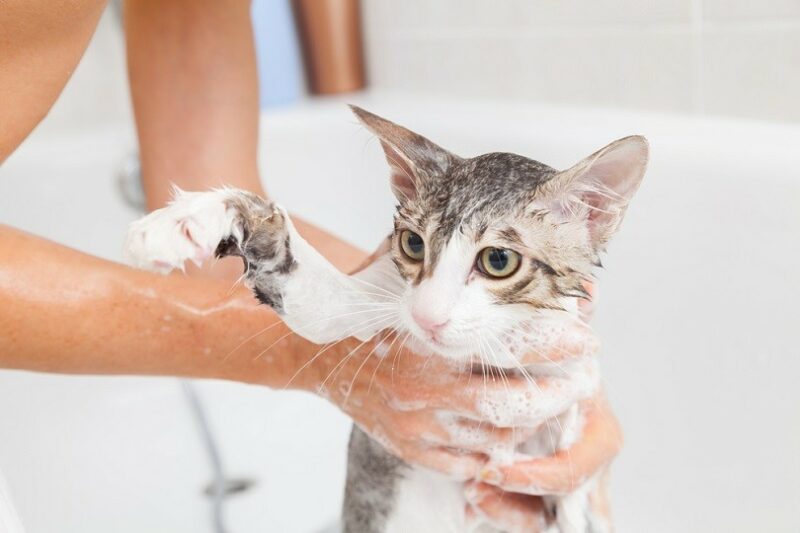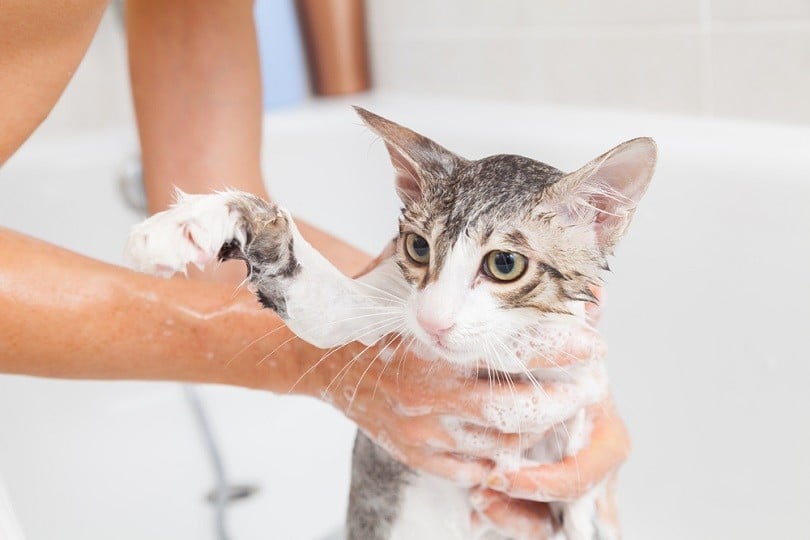
A Quick Comparison of Our Winners (2024)
| Image | Product | Details | ||
|---|---|---|---|---|
| Best Overall |

|
Burt’s Bees Hypoallergenic Cat Shampoo |
|
CHECK PRICE |
| Best Value |
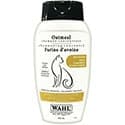
|
Wahl Canada Cat Oatmeal Shampoo |
|
CHECK PRICE |
| Premium Choice |
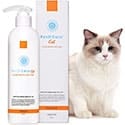
|
Breezytail PetO’Cera Ceramide Infused Cat Shampoo |
|
CHECK PRICE |
| Best for Kittens |
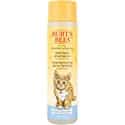
|
Burt’s Bees Tearless Kitten Shampoo |
|
CHECK PRICE |
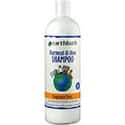
|
Earthbath Oatmeal and Aloe Shampoo |
|
CHECK PRICE |
The Best Cat Shampoo in Canada
1. Burt’s Bees Hypoallergenic Cat Shampoo — Best Overall
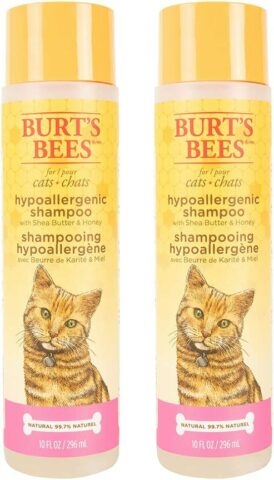
| Ingredients: | Shea butter, honey, beeswax |
| Product size: | 10 fl. ounces |
| Scent: | Honey |
This is a cruelty-free shampoo that tests its formulas on humans first, smells like honey, and leaves your feline friend’s fur as soft as silk. These are just a few of the benefits that this hypoallergenic formula from Burt’s Bees promises, and it’s the best overall cat shampoo available in Canada. The formula is 99.7% natural and contains soothing and nourishing ingredients like shea butter and honey to moisturize your cat’s skin and coat. It also comes at an affordable price. However, to avoid irritation, be careful not to get foam in your pet’s eyes.
- Doesn’t contain any sulfates, colorants, or chemicals
- Will not wash off topical flea-and-tick treatment
- Budget friendly
- Works well to remove dander
- Not heavily perfumed
- Suitable for all life stages
- Can irritate your cat’s eyes
2. Wahl Canada Cat Oatmeal Shampoo — Best Value
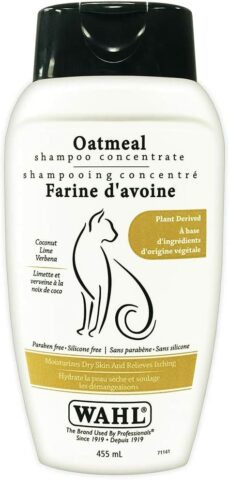
| Ingredients: | Oatmeal, coconut, aloe, lemon verbena |
| Product size: | 15.3 fl. ounces |
| Scent: | Oatmeal |
This formula has a delicious smell of oats, doesn’t have parabens or alcohol, and is based on plant-derived ingredients, including aloe and lemon verbena, that soothe itchy and irritated skin while leaving the coat as soft as silk. This oatmeal shampoo from Wahl Canada is the best cat shampoo in Canada for the money, so you can’t go wrong with this product.
You don’t need to use much to get all the dirt and odor out of your pet’s coat. However, there is no pump on the bottle. This means you’ll have to struggle with your cat and the bottle to apply the product successfully.
- Only a small amount of product is needed
- Pleasant smell of oatmeal
- Paraben and silicone free
- Leaves fur silky and easy to detangle
- Bottle design could be improved
3. Breezytail PetO’Cera Ceramide Infused Cat Shampoo — Premium Choice
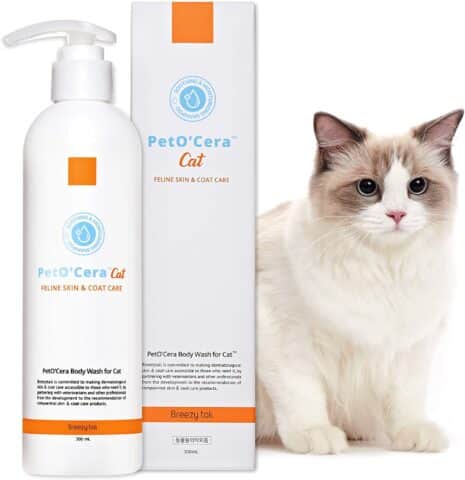
| Ingredients: | Water, allantoin, ceramide |
| Product size: | 10.1 fl. ounces |
| Scent: | Fresh and clean |
Breezytail PetO’Cera Body Wash is a veterinarian-formulated, ceramide-infused shampoo that helps protect and restore your feline friend’s skin barrier. PetO’Cera is a brand that prides itself on being transparent with its customers and disclosing all its ingredients.
However, although the smell of this shampoo is pleasant and not too intense, the formula contains perfumes, which can irritate more sensitive cats. Therefore, it is best to test a small amount of product on your pet’s coat and discontinue use if you notice any redness or itching. Still, the formula is supposed to be hypoallergenic and contains natural ingredients to soothe and relieve skin, so chances are that your cat will respond well to this premium shampoo.
- Vet-approved formula for sensitive skin
- Cruelty free
- Nice and not too overpowering smell
- Soothing and gentle shampoo
- Ceramide helps protect and restore the skin barrier
- Contains fragrances that may irritate the skin in some cats
4. Burt’s Bees Tearless Kitten Shampoo — Best for Kittens

| Ingredients: | Buttermilk powder, honey, beeswax |
| Product size: | 10 fl. ounces |
| Scent: | Honey |
Cute kittens often need a helping hand to groom themselves. However, their fragile skin requires special attention. Moreover, they do not have the same fat reserves as healthy adult cats, hence the importance of keeping their body temperature in check during and after baths.
That said, Burt’s Bees Tearless Shampoo is a great option for your tiny feline, as its formula is free of parabens, dyes, and sulfates and is pH balanced to be kind to their sensitive skin. The scent is also subtle but will have your kitten’s coat smelling divine and fresh after every bath. It also leaves the fur super soft and fluffy, while its moisturizing formula effectively reduces skin itching.
There are two drawbacks, however. First, this shampoo does not generate much foam, so you must use a good amount of it to distribute all over your kitten’s body. Also, despite the term “tearless,” you must avoid any contact with your kitten’s eyes due to the risk of irritating them.
- pH balanced for kittens’ sensitive skin
- No parabens, sulfates, or colorants
- Affordable
- Fresh and subtle scent
- Doesn’t foam much
- Not as “tearless” as the name suggests
5. Earthbath Oatmeal and Aloe Shampoo

| Ingredients: | Purified water, organic aloe vera, vitamins A and E |
| Product size: | 16 fl. ounces |
| Scent: | Fragrance free |
Earthbath shampoo is fragrance free and made with a blend of natural ingredients like organic aloe vera and colloidal oatmeal to heal and rehydrate dry skin. It’s also free of soap, parabens, sulfates, and other possible irritants and is safe to use on the delicate skin of little kittens over 6 weeks old. It is in the higher price range, but you don’t need to use much of the product, as this formula is more concentrated than other budget pet shampoos on the market.
- No soap, parabens, sulfates, or phthalates
- Safe for kittens over 6 weeks
- Fragrance free for sensitive skin
- Pricey
6. WAHL Cat Waterless Shampoo
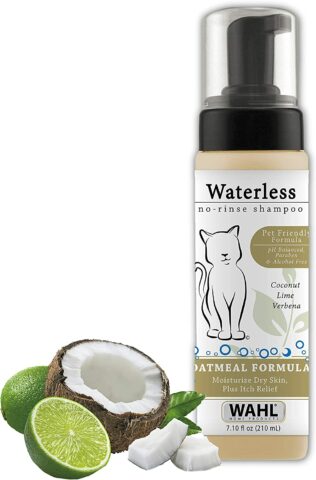
| Ingredients: | Oatmeal extract |
| Product size: | 210 ml |
| Scent: | Coconut lime |
WAHL Waterless Shampoo is designed to remove odors and dirt from your cat’s coat between baths. It soothes sensitive skin and leaves a fresh coconut scent (although it’s a bit strong for some users). It is an ideal option to remove dirt accumulated in the hair without having to use water, but keep in mind that this shampoo does not replace baths. Nevertheless, the formula made with plant derivatives and without alcohol or parabens is perfect for a quick touch-up. In fact, it’s very similar to dry shampoo for humans!
- No rinsing necessary
- Alcohol and paraben free
- Doesn’t leave a greasy residue on the fur
- Made with all-natural plant-derived ingredients
- Not meant to replace regular baths
- Coconut scent might be too strong for some users
7. Vet’s Best No-Rinse
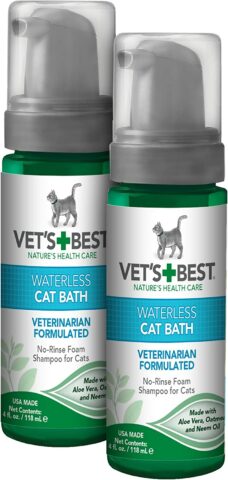
| Ingredients: | Neem oil, vitamin E, aloe vera |
| Product size: | 4 fl. ounces |
| Scent: | Fresh |
Pet owners who struggle with cats that turn into real monsters every time they approach a bath will appreciate this waterless shampoo from Vet’s Best. It’s easy to use: Just apply a small amount of product directly to your pet’s coat, and lather. After a few minutes, wipe off the residue with a clean cloth, followed by a good brushing session to remove dead skin, dead hair, and dandruff. Then, you’ll have a kitty that has silky fur and hydrated skin and is happy to have avoided all contact with water! Also, since this product was formulated by veterinarians, you’ll find soothing natural ingredients, such as aloe, vitamin E, and neem oil (which are said to have anti-inflammatory and moisturizing properties).
However, this shampoo is quite pricey, and its smell will not appeal to everyone. Indeed, neem oil is known to have a particular scent that’s slightly reminiscent of garlic, though it’s masked by a strong musky smell in this shampoo. That said, most users haven’t been bothered by it, so it comes down to individual tastes.
- Limited-ingredient list
- Can be used on kittens 3 months and older
- Formulated and recommended by vets
- No water or rinsing required
- Pricey
- Strong musky scent
8. John Paul Pet Oatmeal Shampoo
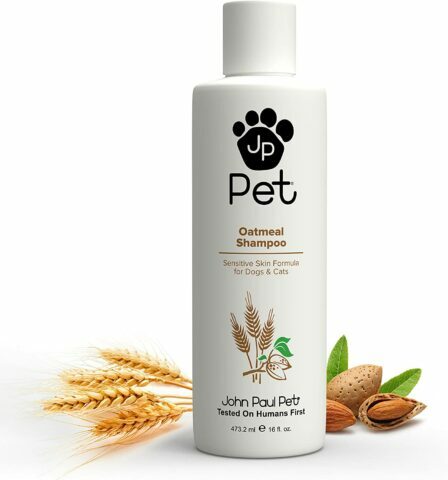
| Ingredients: | Almond oil, aloe, chamomile, hydrolyzed oat protein |
| Product size: | 16 fl. ounces |
| Scent: | Almond |
This John Paul Oatmeal Shampoo is a concentrated formula made with botanical ingredients, like chamomile and aloe vera, that is gentle on your furry friend’s skin. It is also suitable for dogs, so there is no need to buy multiple different shampoos for all your pets! The almond smell is also pleasant but does not last long enough. In addition, although this shampoo does make the skin softer and reduces dandruff, it tends to leave a greasy residue on the hair.
- Nourishing formula with almond oil and aloe to soothe dry skin
- Cruelty-free formula that has been tested on humans first
- Relieves itching by reducing dandruff
- Lovely almond scent but does not last long
- Tends to leave a greasy residue
Buyer’s Guide: How to Pick the Best Cat Shampoo
Why Should You Bathe Your Cat?
The benefits of cat shampoos go beyond simply giving your kitty a fresh scent. Regular bathing can also help protect your cat’s skin from allergies and infections. While many cats seem to tolerate occasional baths, others may scratch and bite if they are not kept in a calm, controlled environment. If your cat has sensitive skin, shampoos with natural ingredients can protect against irritation. Regular baths are also a great way to check for health issues like fleas, lice, and skin infections, including ringworm and bacterial infections. If your cat is scratching excessively, has red and scaly skin, or is losing hair, bathing them with a gentle cat shampoo can be a useful part of your regular care as well as trips to the vet.
What to Look for When Choosing a Cat Shampoo
Before you grab the first bottle of feline shampoo that you see, there are a few things to keep in mind when shopping for the best cat shampoo. First, does it actually get rid of the odors that you want? Is it free of perfumes, dyes, and other harsh chemicals? Many cat parents prefer to use natural shampoos on their cats due to the lack of fragrance in these products. If you want one of these, be sure to choose a brand that discloses all its ingredients, and check that it is indeed free of harmful chemicals. You can also try a conditioner after bathing your cat to get rid of knots and help keep your kitty’s coat soft and smooth.
How to Find the Right Shampoo for Your Cat
While there are many types of cat shampoos on the market, some are better suited to certain types of cats than others. For example, if your cat has skin conditions, you may want to avoid soaps that can be too harsh. Also, if your cat has long fur, you may want to use a shampoo that contains conditioners.
Cats are known to be fairly finicky creatures, so if you can find a shampoo that both you and your cat can agree on, all the better!
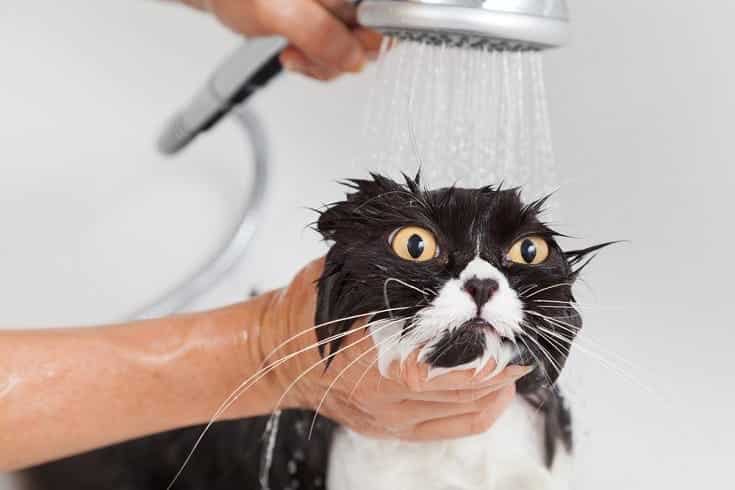
Which Ingredients to Look for in a Good Cat Shampoo
When it comes to cat shampoos, natural is best. Here are a few of the best ingredients to look for in a good cat shampoo:
- Oatmeal. Cats with sensitive skin will benefit from oatmeal’s soothing properties. Oatmeal-based shampoos are also ideal for cats with allergies.
- Shea butter. Shea butter is a natural conditioner that can help keep your cat’s coat soft and smooth.
- Coconut Oil. Coconut oil is known for its antibacterial properties. It can also keep your cat’s skin soft.
Which Ingredients to Avoid in a Cat Shampoo
While many ingredients are perfectly harmless to humans, there are a few that you’ll want to avoid in a cat shampoo:
- Fragrances. Although fragrances are common in pet shampoos, they can be harmful to more sensitive cats and cause skin irritations and allergies.
- Sulfates. Sulfates, such as sodium lauryl sulfate and sodium laureth sulfate, are common foaming agents in shampoos. While they may be useful in keeping your cat’s fur from getting too dirty, they can be harmful to your pet’s skin.
How to Bathe Your Cat
If you’ve ever tried to bathe a cat, you know that these animals are not always the most cooperative. But bathing your kitty is a necessary part of caring for them. It’s important to approach the chore with caution and respect:
- Never use human shampoo on your cat; it could be toxic to them and could also lead to dry skin. Instead, use a gentle, pH-balanced formula designed specifically for cats.
- Be sure to rinse your cat’s fur thoroughly to avoid skin irritation.
- Be careful not to get soap in their eyes or ears, as contact with these areas could cause irritation.
Conclusion
Cats are clean animals by nature, but they can benefit from a good shampoo once in a while. With a few simple tips, you can find a shampoo that’s gentle enough for your feline friend and likely to leave them smelling great.
Burt’s Bees hypoallergenic formula is our top overall pick for its gentle, natural ingredients that will keep your fur baby looking fabulous, healthy, and smelling great. Although Burt’s Bees shampoos are generally affordable, you can really get your money’s worth with Wahl Canada’s Oatmeal Shampoo. If you’re ready to splurge, PetO’Cera’s vet-approved Breezytail Ceramide Shampoo will do the trick.
We hope that these reviews help you choose a shampoo that will make you and your cat purr!
Featured Image Credit: 135pixels, Shutterstock
Contents
- A Quick Comparison of Our Winners (2024)
- The Best Cat Shampoo in Canada
- 1. Burt’s Bees Hypoallergenic Cat Shampoo — Best Overall
- 2. Wahl Canada Cat Oatmeal Shampoo — Best Value
- 3. Breezytail PetO’Cera Ceramide Infused Cat Shampoo — Premium Choice
- 4. Burt’s Bees Tearless Kitten Shampoo — Best for Kittens
- 5. Earthbath Oatmeal and Aloe Shampoo
- 6. WAHL Cat Waterless Shampoo
- 7. Vet’s Best No-Rinse
- 8. John Paul Pet Oatmeal Shampoo
- Buyer’s Guide: How to Pick the Best Cat Shampoo
- Why Should You Bathe Your Cat?
- What to Look for When Choosing a Cat Shampoo
- How to Find the Right Shampoo for Your Cat
- Which Ingredients to Look for in a Good Cat Shampoo
- Which Ingredients to Avoid in a Cat Shampoo
- How to Bathe Your Cat
- Conclusion


